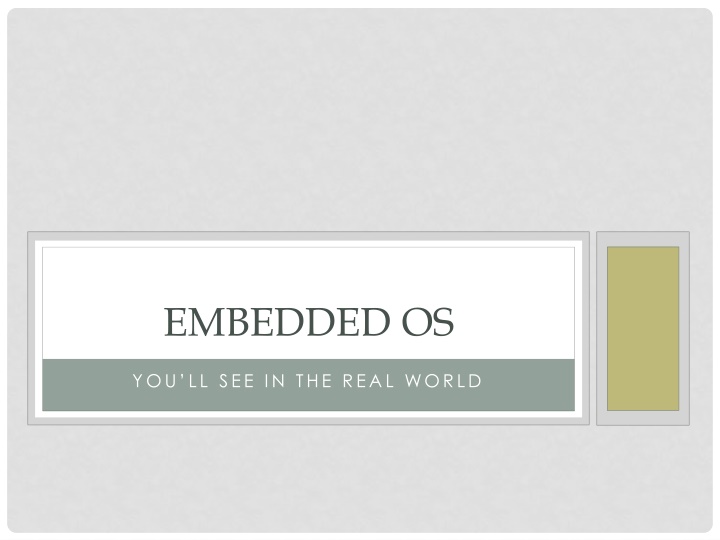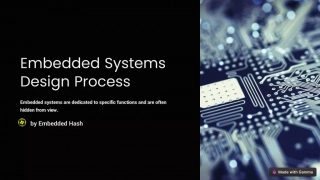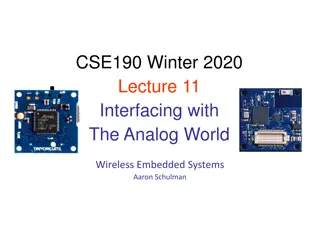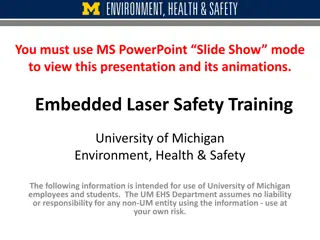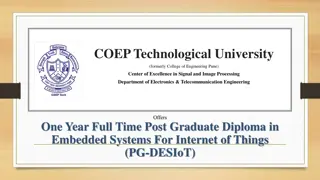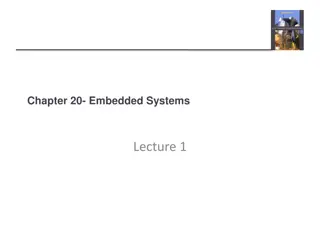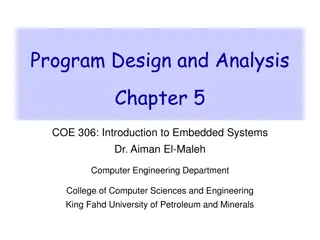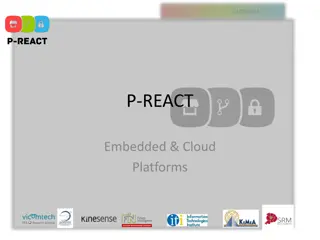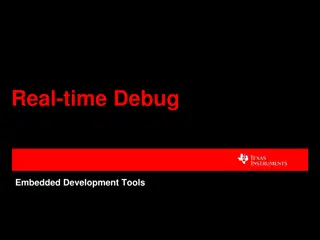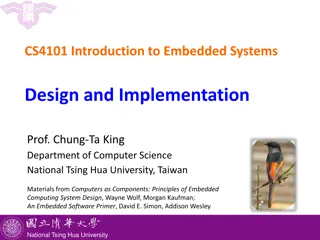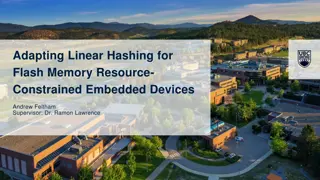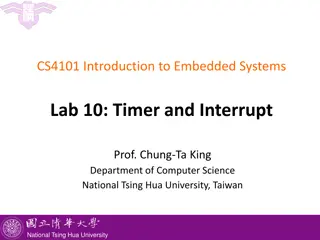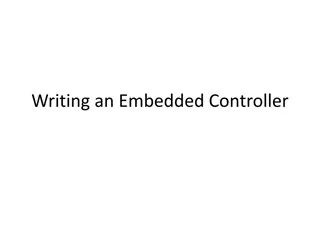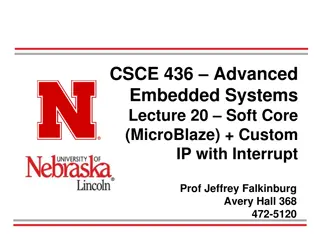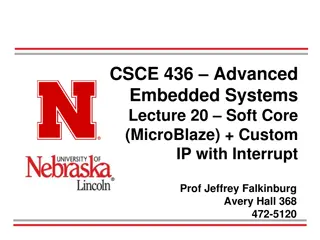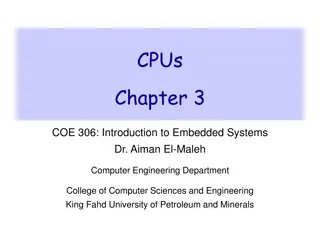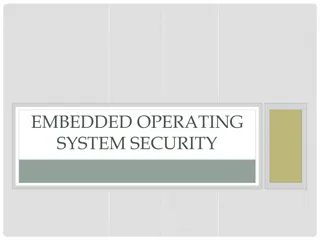EMBEDDED OS
Cisco IOS, the Internetwork Operating System developed in the 1980s, is a crucial component of many Cisco routers, switches, and firewalls. Initially designed for routers with limited RAM, it has evolved to run on a modified Linux kernel. The architecture follows a monolithic kernel approach, offering direct hardware access to processes to optimize CPU performance. The primary CLI interface allows access through SSH, Telnet, and serial connections, with fixed commands and privileged modes. Despite its benefits, IOS does face security vulnerabilities, such as weak password encryption. Understanding its unique features like storage of running and startup configurations in volatile and non-volatile memory is essential for effective network management.
Uploaded on Mar 08, 2025 | 1 Views
Download Presentation

Please find below an Image/Link to download the presentation.
The content on the website is provided AS IS for your information and personal use only. It may not be sold, licensed, or shared on other websites without obtaining consent from the author.If you encounter any issues during the download, it is possible that the publisher has removed the file from their server.
You are allowed to download the files provided on this website for personal or commercial use, subject to the condition that they are used lawfully. All files are the property of their respective owners.
The content on the website is provided AS IS for your information and personal use only. It may not be sold, licensed, or shared on other websites without obtaining consent from the author.
E N D
Presentation Transcript
EMBEDDED OS YOU LL SEE IN THE REAL WORLD
CISCO IOS Cisco Internetwork Operating System Developed in the 1980s For routers with less than 256kB of RAM Used on many Cisco routers, switches, and firewalls Originally a stand alone kernel Now runs on a modified Linux kernel
INTERFACE Primary interface is a CLI Access through SSH Telnet Serial Has a fixed set of commands Has privileged modes (used to restrict specific commands)
ARCHITECTURE Monolithic kernel architecture All processes have direct hardware access to reduce CPU time
ARCHITECTURE Monolithic kernel architecture All processes have direct hardware access to reduce CPU time No memory protection Run-to-completion process scheduling No pre-emption No paging or swapping In the event of an IOS crash, the operating system automatically reboots and reloads the saved configuration More on this later
SECURITY AND VULNERABILITIES IOS devices can support centralized login For emergency purposes, there is often a local account Because IOS needs the plaintext password, all local passwords are weakly encrypted And thus easily decrypted But how do we get the encrypted password?
RUNNING VS START-UP CONFIG IOS has two configurations: Running Start-up The running configuration is stored in RAM Volatile The startup configuration is stored in NVRAM Non-Volatile
CONFIG Any changes made in the CLI effect the running config When the running config is saved, IOS dynamically builds a text file with the CLI commands necessary to achieve the running configuration This file becomes the startup config
EXAMPLE ! version 12.3 no service pad service timestamps debug datetime msec service timestamps log datetime msec no service password-encryption ! hostname retail ! boot-start-marker boot-end-marker ! enable password cisco123 ! username jsomeone password 0 cg6#107X aaa new-model ! aaa group server radius rad_eap server 10.0.1.1 auth-port 1812 acct-port 1813 !
EXAMPLE ! version 12.3 no service pad service timestamps debug datetime msec service timestamps log datetime msec no service password-encryption ! hostname retail ! boot-start-marker boot-end-marker ! enable password cisco123 ! username jsomeone password 0 cg6#107X aaa new-model ! aaa group server radius rad_eap server 10.0.1.1 auth-port 1812 acct-port 1813 !
EXAMPLE ! version 12.3 no service pad service timestamps debug datetime msec service timestamps log datetime msec no service password-encryption ! hostname retail ! boot-start-marker boot-end-marker ! enable password cisco123 ! username jsomeone password 0 cg6#107X aaa new-model ! aaa group server radius rad_eap server 10.0.1.1 auth-port 1812 acct-port 1813 !
JUST BTW Every device needs a local startup config Also Most config files are archived for backup purposes
IOS Released in 2007 Unix-like Based on the XNU Darwin Kernel (BSD) Written in: C, C++, Objective-C, Swift
ARCHITECTURE XNU Originally developed by NeXT for the NeXTSTEP operating system Hybrid kernel Features: Memory protection Message Processing Multiprocessing support
SECURITY Secure Boot Secure Enclave Passcode Touch ID Address Space Layout Randomization Non-Executable Memory Encryption App Security Network Security
APP STORE BYPASS Companies can apply to Apple for enterprise developer certificates These can be used to sign apps such that iOS will install them directly
ANDROID Released in 2008 Based on modified Linux Kernel Written in Java, C, C++
ARCHITECTURE Based on modified LST Linux Kernel Meaning micro-kernel The flash storage split into several partitions /system /data Android device owners are not given root access root access can be obtained by exploiting security flaws in Android
SECURITY Android's source code is released by Google under an open source license Meaning many different (often incompatible) flavors Rely on carriers for OS updates Sandbox mode for applications
